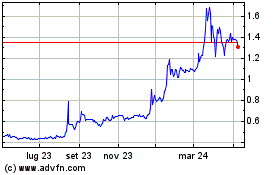Fannie Mae Unveils Mortgage Program to Help Minority Borrowers
25 Agosto 2015 - 8:00PM
Dow Jones News
Fannie Mae wants to make it easier for working-class and
multigenerational households to get mortgages.
The mortgage-finance company said Tuesday that it will roll out
a program this year that lets lenders include income from
nonborrowers within a household, such as extended family members,
toward qualifying for a loan.
The move is expected to open up mortgage access to a segment of
the population that doesn't fit the typical family structure and
has had trouble obtaining mortgages. In households of some minority
groups, such as Hispanics, it is common to have extended family
members contributing income to the cost of housing, though until
now that income couldn't be used to help qualify for a loan.
The new program, which is only open to low-income borrowers or
those living in low-income or minority-dominated areas, will also
in some cases let nonoccupant borrowers, such as parents,
contribute income toward qualifying for a loan. Families with
boarders will also be allowed to count that rent toward
qualifying.
Fannie officials said their research indicated that extended
households have incomes as stable or more stable than other kinds
of households.
Fannie Mae and competitor Freddie Mac don't make loans. They buy
them from lenders, package them into securities and provide
guarantees to make investors whole if the loans default.
After the financial crisis, Fannie, Freddie and lenders greatly
strengthened the requirements borrowers had to meet to get loans.
The moves, such as increasing down-payment and credit-score
requirements, had the effect of lowering default rates for
homeowners but also shut out from the mortgage market many
borrowers who previously qualified.
Over the past couple of years, Fannie, Freddie and lenders have
loosened some of those restrictions. In late 2014 and early 2015,
Fannie and Freddie, for example, reintroduced programs that allow
down payments of as little as 3%, down from the previous 5%
minimum.
However, some advocates for increased minority homeownership
have argued that the companies should also make changes reflecting
the unique characteristics of the minority groups that are making
up an increasing share of new households.
Some groups, for example, have pushed the Federal Housing
Finance Agency, which regulates Fannie and Freddie, to adopt more
modern credit-scoring models that can take into account rent or
utility payments, which would help minority borrowers with scant
credit history.
Some lenders believe that such changes are critical to
addressing the country's changing demographics. In the next decade,
three in four new households will be formed by minorities,
according to researchers at the Urban Institute.
To qualify for loans under Fannie's new program, borrowers must
make less than 80% of their area's median income, buy a home in a
low-income census tract, or make less than 100% of the area's
median and buy a home in a high-minority census tract or designated
natural disaster area.
Fannie said the new program, which starts in late 2015, will
allow down payments of as little as 3%.
Write to Joe Light at joe.light@wsj.com
Subscribe to WSJ: http://online.wsj.com?mod=djnwires
(END) Dow Jones Newswires
August 25, 2015 13:45 ET (17:45 GMT)
Copyright (c) 2015 Dow Jones & Company, Inc.
Grafico Azioni Federal Home Loan Mortgage (QB) (USOTC:FMCC)
Storico
Da Mar 2024 a Apr 2024

Grafico Azioni Federal Home Loan Mortgage (QB) (USOTC:FMCC)
Storico
Da Apr 2023 a Apr 2024
